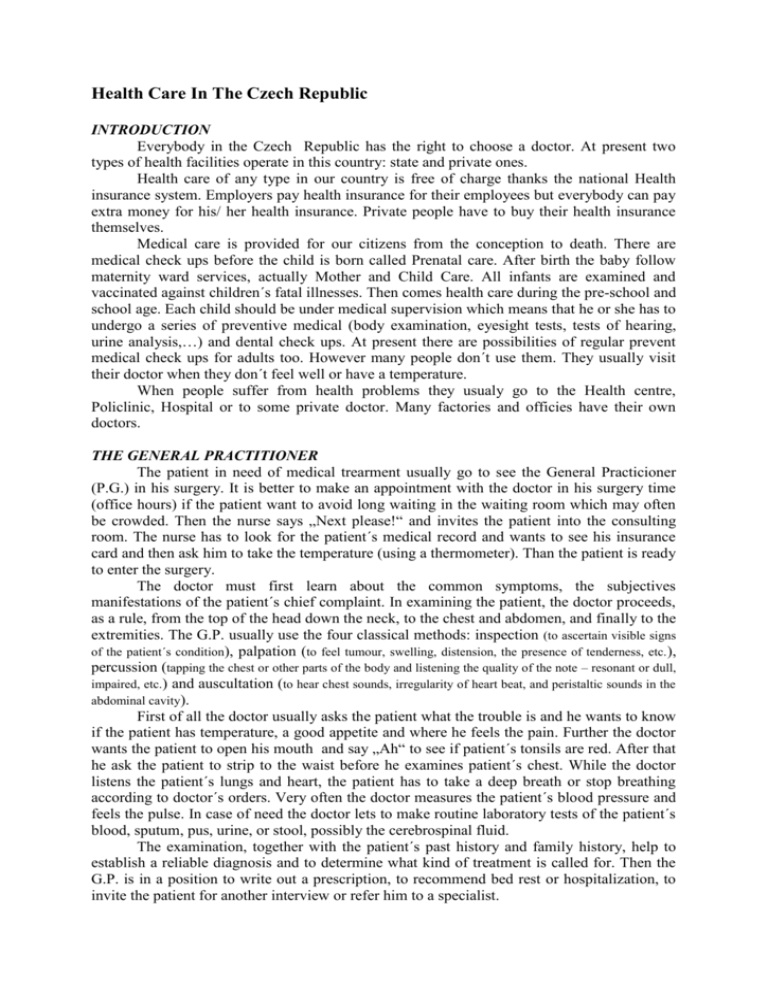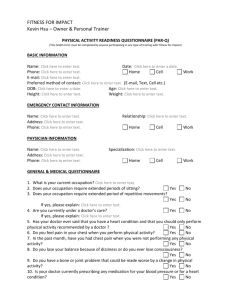Health Care In The Czech Republic
advertisement

Health Care In The Czech Republic INTRODUCTION Everybody in the Czech Republic has the right to choose a doctor. At present two types of health facilities operate in this country: state and private ones. Health care of any type in our country is free of charge thanks the national Health insurance system. Employers pay health insurance for their employees but everybody can pay extra money for his/ her health insurance. Private people have to buy their health insurance themselves. Medical care is provided for our citizens from the conception to death. There are medical check ups before the child is born called Prenatal care. After birth the baby follow maternity ward services, actually Mother and Child Care. All infants are examined and vaccinated against children´s fatal illnesses. Then comes health care during the pre-school and school age. Each child should be under medical supervision which means that he or she has to undergo a series of preventive medical (body examination, eyesight tests, tests of hearing, urine analysis,…) and dental check ups. At present there are possibilities of regular prevent medical check ups for adults too. However many people don´t use them. They usually visit their doctor when they don´t feel well or have a temperature. When people suffer from health problems they usualy go to the Health centre, Policlinic, Hospital or to some private doctor. Many factories and officies have their own doctors. THE GENERAL PRACTITIONER The patient in need of medical trearment usually go to see the General Practicioner (P.G.) in his surgery. It is better to make an appointment with the doctor in his surgery time (office hours) if the patient want to avoid long waiting in the waiting room which may often be crowded. Then the nurse says „Next please!“ and invites the patient into the consulting room. The nurse has to look for the patient´s medical record and wants to see his insurance card and then ask him to take the temperature (using a thermometer). Than the patient is ready to enter the surgery. The doctor must first learn about the common symptoms, the subjectives manifestations of the patient´s chief complaint. In examining the patient, the doctor proceeds, as a rule, from the top of the head down the neck, to the chest and abdomen, and finally to the extremities. The G.P. usually use the four classical methods: inspection (to ascertain visible signs of the patient´s condition), palpation (to feel tumour, swelling, distension, the presence of tenderness, etc. ), percussion (tapping the chest or other parts of the body and listening the quality of the note – resonant or dull, impaired, etc.) and auscultation (to hear chest sounds, irregularity of heart beat, and peristaltic sounds in the abdominal cavity). First of all the doctor usually asks the patient what the trouble is and he wants to know if the patient has temperature, a good appetite and where he feels the pain. Further the doctor wants the patient to open his mouth and say „Ah“ to see if patient´s tonsils are red. After that he ask the patient to strip to the waist before he examines patient´s chest. While the doctor listens the patient´s lungs and heart, the patient has to take a deep breath or stop breathing according to doctor´s orders. Very often the doctor measures the patient´s blood pressure and feels the pulse. In case of need the doctor lets to make routine laboratory tests of the patient´s blood, sputum, pus, urine, or stool, possibly the cerebrospinal fluid. The examination, together with the patient´s past history and family history, help to establish a reliable diagnosis and to determine what kind of treatment is called for. Then the G.P. is in a position to write out a prescription, to recommend bed rest or hospitalization, to invite the patient for another interview or refer him to a specialist. Medical suitcase – equipment of the G.P. Fonendoscope – fonendoskop Thermometer – teploměr Syringe sirindž –injekční stříkačka Tendon hammer – kladívko na zjišťování motorických reflexů Patellar hammer – kladívko na zjišťování patelárního reflexu Tongue depressor – „lžíce“ k prohlížení jazyka a zadní oblasti ústní dutiny Tweezers twi:z s – pinzeta Scissors – nůžky Dropper – kapátko Wisp of cotton wool – vatový tampón Kidney bowl – miska ledvinovitého tvaru Specular – dentální zrcátko Sterilized gloves – sterilní rukavice Prescription – lékařský předpis






